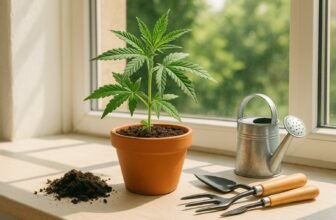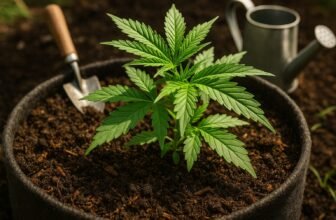
Drying weed outdoors is a crucial step in the cannabis cultivation process, significantly impacting your buds’ overall potency, flavor, and aroma. Proper drying and curing not only preserve the plant’s natural terpenes and cannabinoids but also prevent mold and mildew, ensuring a safe, high-quality final product. For cannabis growers, especially beginners, mastering the art of outdoor drying can seem challenging due to factors such as unpredictable weather, fluctuating humidity, and the need for proper airflow.
In this comprehensive guide, you’ll learn exactly how to dry weed outdoors effectively, leveraging natural resources to your advantage. We’ll break down essential drying techniques, including harvesting, trimming, hanging buds, and transitioning from drying to curing cannabis. You’ll also discover valuable tips on choosing the best outdoor drying location, preventing common pitfalls like mold growth or overdrying, and understanding optimal drying times.
Whether you’re new to outdoor cannabis drying or simply looking to enhance your existing methods, this guide is designed with your success in mind—covering everything from simple DIY setups to expert advice on humidity control and ideal temperature conditions. By following these best practices, you’ll maximize your cannabis yield’s quality, potency, and aroma while ensuring a smooth, enjoyable smoking experience.
Drying weed outdoors involves hanging trimmed cannabis buds in a shaded, well-ventilated area with controlled humidity (45–55%) and temperature (60–75°F) for 7–14 days. This natural method preserves potency, flavor, and aroma while preventing mold. Avoid direct sunlight, maintain airflow, and monitor conditions regularly for best results before curing.
Why Dry Weed Outdoors?
Drying weed outdoors offers several practical advantages, making it a favored method among home cultivators and professional growers alike. One of the most appealing aspects is its cost-effectiveness—outdoor drying leverages natural airflow, ambient temperatures, and indirect sunlight, significantly reducing the need for expensive indoor drying equipment like humidity-controlled drying rooms or industrial fans.
Another essential benefit of drying cannabis naturally outdoors is the superior airflow. Proper airflow is crucial to avoid moisture buildup, which often leads to mold or mildew formation. Outdoor drying conditions, when managed correctly, help maintain optimal humidity and circulation around your cannabis buds, preserving their potency and freshness. Unlike indoor drying methods that might require constant monitoring and artificial climate control, outdoor drying can simplify the process, provided you have selected a well-ventilated location with stable conditions.
Outdoor drying also enhances the buds’ natural terpene profile, as slow drying under shaded, airy conditions preserves aroma and flavor compounds more effectively. This process naturally maintains cannabinoids and terpenes, ensuring your cannabis is flavorful, potent, and enjoyable.
However, growers must also be mindful of some inherent challenges, including unpredictable weather and pest management. Unforeseen rain or humidity spikes can disrupt your drying progress, potentially leading to mold or bud rot if precautions are not taken. Likewise, pests and contamination can pose threats to your drying weed outdoors. Therefore, selecting a secure, clean, and weather-protected area is essential to successfully drying cannabis outdoors.
By strategically managing these environmental factors, outdoor drying becomes an advantageous method for growers aiming for quality cannabis while keeping operational costs low.
Choosing the Ideal Outdoor Drying Location
Selecting the ideal outdoor drying location for your cannabis is crucial for achieving buds with superior potency, aroma, and overall quality. A carefully chosen location significantly reduces the risks of mold, pests, and environmental damage, making it an essential step in the outdoor drying process.
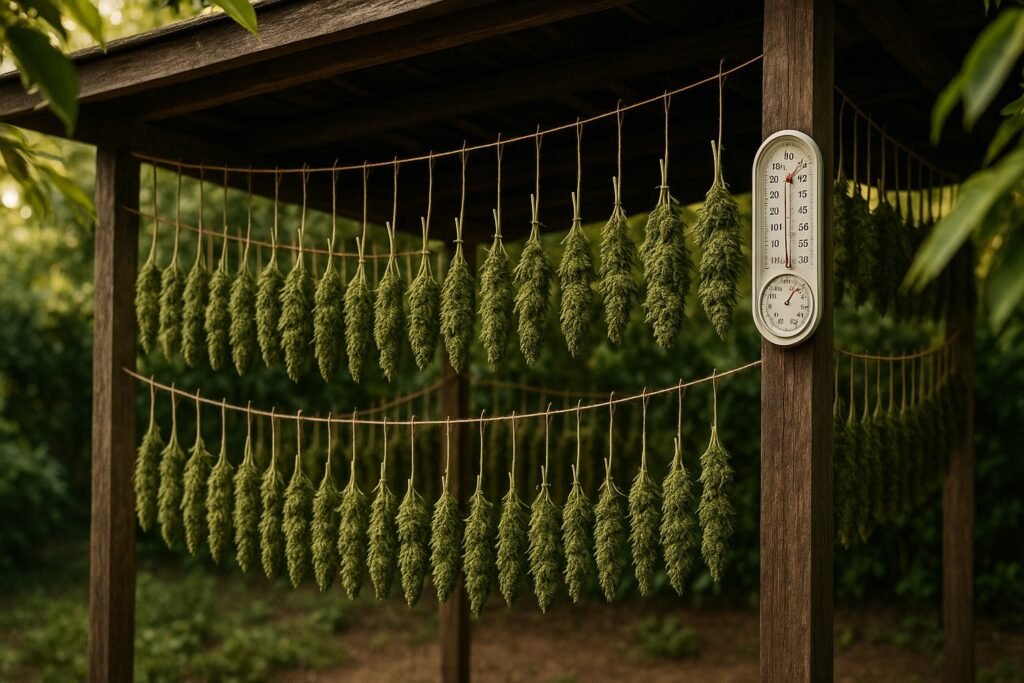
Key Considerations for Outdoor Cannabis Drying Location
When choosing a suitable drying spot, prioritize areas that offer excellent air circulation. Proper airflow prevents stagnant moisture, reducing the risk of mold and mildew development on your buds. Consider open yet sheltered spaces that allow fresh air to circulate continuously without strong direct winds that may damage delicate trichomes.
Managing humidity and temperature is another critical factor. An optimal drying location should maintain a humidity level between 45-55% and temperatures ranging from 60°F to 75°F (15°C–24°C). Avoid places prone to moisture accumulation or areas exposed to frequent temperature fluctuations, which could harm your cannabis buds or prolong drying time excessively.
Protecting your cannabis from direct sunlight is equally important. Excessive exposure to sunlight or UV rays degrades essential cannabinoids and terpenes, significantly diminishing the quality, potency, and aromatic profile of your marijuana buds. Choose shaded areas or covered outdoor spaces that offer indirect sunlight or filtered natural lighting.
Lastly, always factor in security and privacy. Since cannabis drying requires days of undisturbed hanging, ensure the drying area is discreet, away from curious eyes, pets, pests, or contaminants. Private garden sheds, covered porches, or specially constructed DIY drying tents often meet these security and discretion needs.
Recommended Outdoor Drying Setups:
- Covered Porches: Offer natural airflow, shade, and convenient monitoring.
- Garden Sheds: Provide excellent shelter, consistent humidity, and temperature control.
- Drying Tents or DIY Boxes: Allow precise control over drying conditions while still benefiting from outdoor airflow.
By carefully evaluating these factors, you’ll create the optimal outdoor drying environment, producing high-quality cannabis buds rich in cannabinoids, terpenes, and unmatched freshness.
Step-by-Step Process of Drying Weed Outdoors
Properly drying your weed outdoors is essential to maintain the quality, potency, and flavor of your harvested buds. Following this step-by-step outdoor drying guide ensures optimal results, safeguarding your cannabis from common drying problems such as mold, overdrying, and terpene degradation.
Harvesting Your Cannabis
Knowing precisely when and how to harvest your cannabis plants significantly impacts the drying outcome. Ideal harvesting occurs when trichomes transition from clear to milky white, with some amber hues. Harvesting too early results in weaker potency, while harvesting too late reduces THC content.
- Harvest early morning to retain terpene freshness.
- Inspect trichomes with a magnifier or jeweler’s loupe.
- Carefully cut branches, minimizing damage to buds.
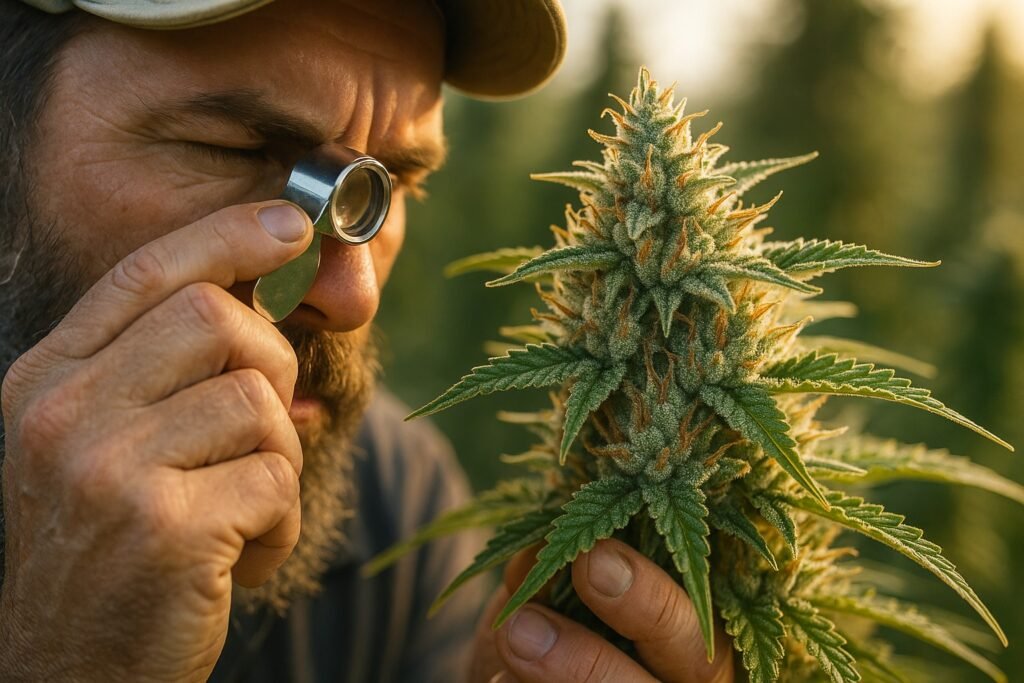
Preparing Buds for Drying
Proper bud preparation before drying is vital to preserving cannabinoid potency and aroma. Trimming excess leaves helps maintain proper airflow and prevents moisture retention that can lead to mold.
- Perform either wet trimming or dry trimming (immediately after harvest or after initial drying period).
- Trim off large fan leaves and excess foliage.
- Decide whether to dry individual buds or whole branches depending on drying space availability.
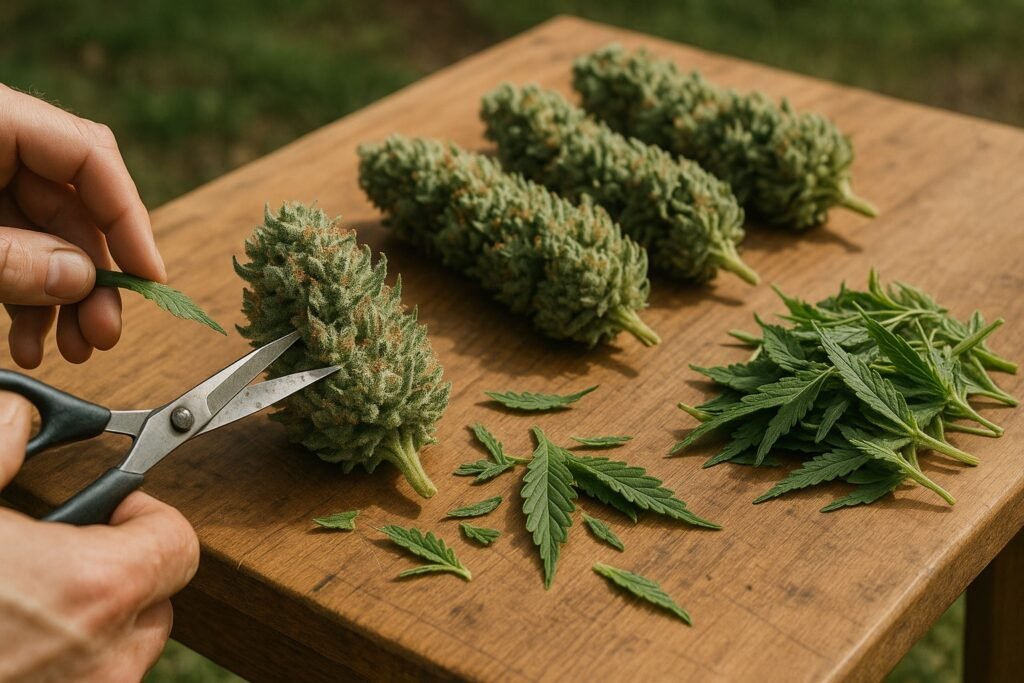
Hanging Cannabis Buds
Correctly hanging cannabis buds is fundamental to ensure even drying and prevent mold development. Proper spacing and methodical hanging contribute significantly to quality preservation.
- Hang buds upside down to facilitate uniform drying.
- Ensure adequate spacing between branches (at least 1–2 inches apart).
- Secure buds in a shaded, sheltered area with optimal airflow.
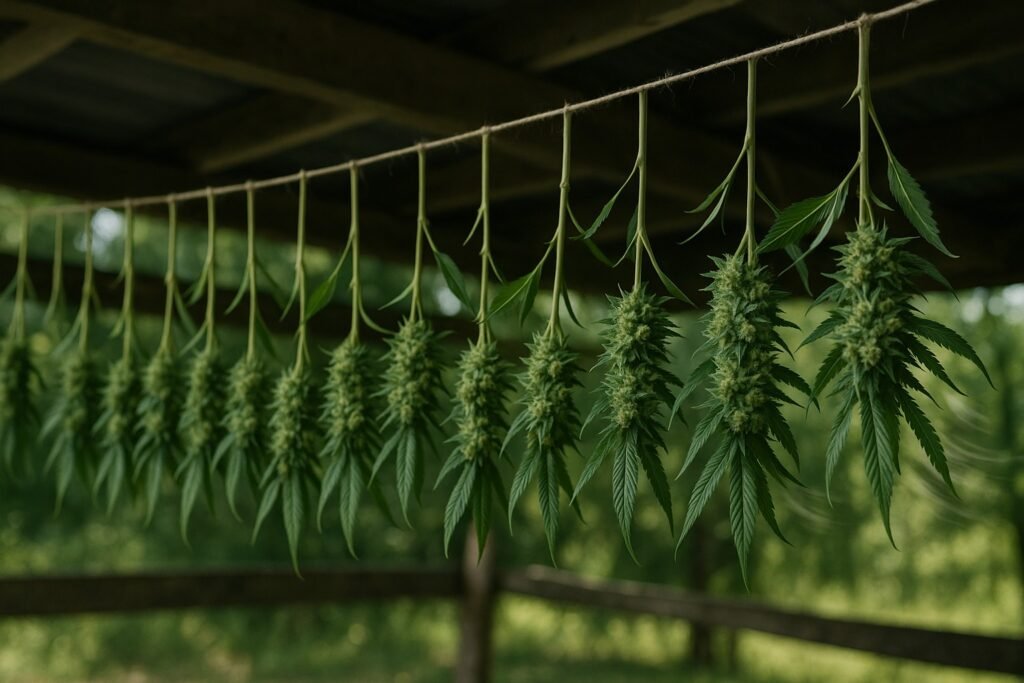
Monitoring Conditions
Maintaining optimal humidity and temperature conditions ensures high-quality drying results. Careful monitoring prevents common drying issues like mold, mildew, and cannabinoid degradation.
- Keep humidity levels around 45-55%.
- Maintain consistent temperatures between 60°F–75°F (15°C–24°C).
- Regularly check buds to detect potential moisture or mold problems early.
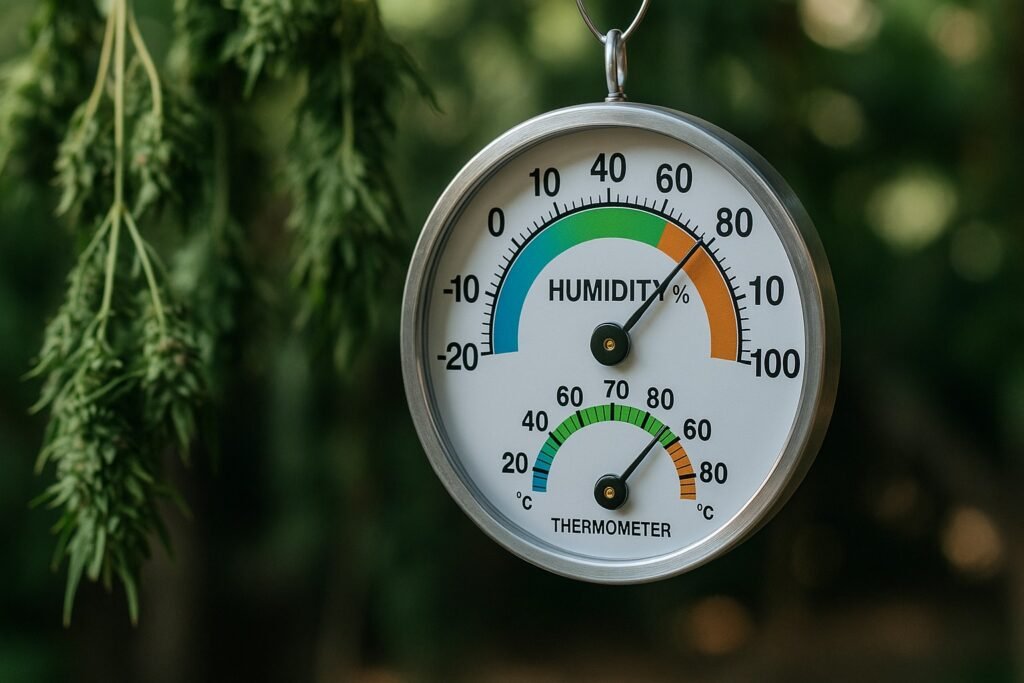
Duration of Drying
The drying duration significantly affects cannabis potency and flavor. Buds dried too quickly lose essential terpenes, whereas overly prolonged drying can risk mold development.
- Ideal drying typically lasts around 7–14 days.
- Buds are ready when branches slightly bend and buds feel crispy on the outside but still somewhat soft inside (snap test).
- Regular checks help achieve ideal moisture levels for transitioning to curing.

Common Mistakes and How to Avoid Them
Drying weed outdoors can yield exceptional cannabis quality, but growers frequently make common mistakes that compromise potency, aroma, and overall bud integrity. Understanding and avoiding these pitfalls will ensure you achieve optimal results every time.
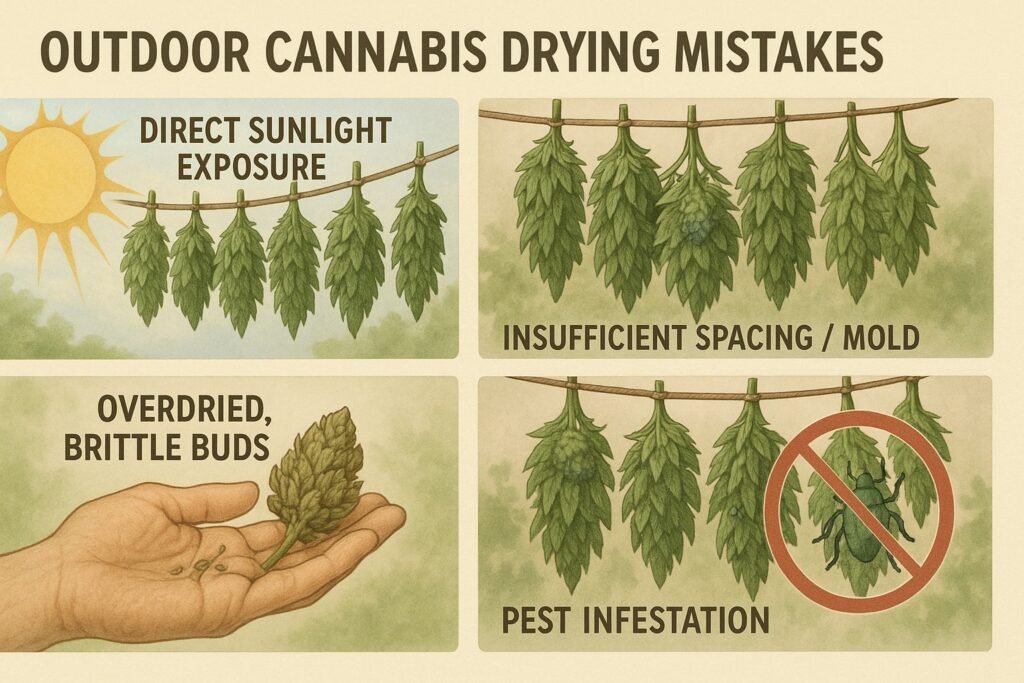
Overdrying Cannabis Buds
Overdrying cannabis outdoors can significantly diminish the buds’ potency and terpene profile. When buds lose excessive moisture, they become brittle, leading to harsh smoke and reduced aroma.
- How to Avoid: Regularly monitor your buds using the stem snap test. Buds are ready for curing when small stems bend slightly before snapping.
Underdrying and Mold Growth
Insufficient drying time outdoors often causes hidden moisture, creating ideal conditions for mold and mildew. Moldy buds not only spoil your cannabis harvest but also pose health risks.
- How to Avoid: Maintain proper airflow and humidity control (45–55%) throughout the drying process. Check buds daily for signs of mold, discarding affected buds immediately.
Exposure to Direct Sunlight
Direct sunlight exposure during drying rapidly degrades THC, cannabinoids, and terpenes, negatively affecting cannabis potency, aroma, and overall quality.
- How to Avoid: Always choose a shaded, sheltered outdoor location with indirect or filtered sunlight. Shade cloths or garden sheds are excellent options to protect buds.
Poor Air Circulation
Inadequate airflow can lead to uneven drying, creating damp pockets within buds that trigger mold formation.
- How to Avoid: Space your cannabis branches adequately (1–2 inches apart) and position them to maximize natural airflow. You can also use small outdoor fans if needed to enhance circulation.
Pest and Contamination Risks
Outdoor drying areas can attract pests and contaminants, jeopardizing the hygiene and safety of your harvest.
- How to Avoid: Regularly inspect your drying cannabis buds for pests or signs of contamination. Set up pest prevention measures like natural repellents, cleanliness, and secure drying spaces.
By avoiding these common cannabis drying mistakes, you’ll significantly enhance the quality, potency, and flavor of your final cannabis buds, ensuring a rewarding and safe smoking experience.
Transitioning from Drying to Curing
Transitioning cannabis from drying to curing is a pivotal step to ensure your buds develop optimal potency, aroma, flavor, and smoothness. While drying primarily removes moisture, the curing process allows for the precise breakdown of residual sugars and chlorophyll, significantly enhancing the cannabis smoking experience.

Understanding Curing Cannabis
Curing cannabis involves carefully controlling moisture levels within airtight containers, typically mason jars, to preserve and enhance cannabinoids and terpenes. Proper curing not only enriches aroma and taste but also stabilizes THC and CBD levels, improving the overall potency and shelf-life of your harvested weed.
Importance of Curing for Flavor and Potency
Skipping or improperly performing curing reduces cannabis quality, resulting in harsher smoke and less flavorful buds. Curing encourages chemical processes within buds, gradually removing grassy or chlorophyll-like tastes and replacing them with the strain’s unique aromatic profile and full flavor. Additionally, curing stabilizes cannabinoid profiles, providing a consistent and potent user experience.
Simple Techniques for Curing Cannabis Outdoors
The most common and effective curing method is using airtight mason jars. Follow these essential steps for a successful curing process:
- After drying, place your cannabis buds loosely inside mason jars, filling about 75% of the jar capacity.
- Seal jars tightly and store them in a cool, dark, stable environment (around 60–70°F / 15–21°C).
- “Burp” jars daily during the first week, briefly opening them to release built-up moisture and circulate fresh air. Gradually decrease the frequency of burping after one week.
- Maintain ideal humidity levels of around 58–62% inside jars using hygrometers or humidity packs to avoid overdrying or mold.
By carefully transitioning from drying to curing, you significantly enhance the final quality, aroma, flavor, and potency of your cannabis harvest, delivering consistently enjoyable and satisfying buds.
Expert Tips for Successful Outdoor Drying
Achieving optimal results when drying weed outdoors requires careful attention to detail and adherence to best practices. Below are expert tips to ensure your outdoor drying process yields cannabis buds with maximum potency, aromatic profile, and superior quality.
Use Drying Nets or Racks
Drying nets or racks provide an efficient solution for drying cannabis outdoors, especially if space is limited. These tools enhance airflow and ensure uniform drying, minimizing mold risks and uneven moisture levels. Arrange buds evenly on nets or racks to maintain ideal air circulation and prevent overlapping, ensuring all buds dry at a consistent rate.
Incorporate Fans for Improved Airflow
Natural airflow is typically sufficient outdoors; however, supplementing with small battery-powered or solar fans can significantly improve drying efficiency and consistency, particularly in humid environments. Fans facilitate continuous airflow, reducing stagnant moisture pockets that may otherwise foster mold growth and degradation of cannabinoids and terpenes.
Simple Humidity Control Tricks
Managing humidity outdoors can be challenging, but employing simple tricks can substantially mitigate issues:
- Use silica gel packs or moisture absorbers placed strategically around your drying cannabis buds to reduce excessive humidity.
- Utilize a shade cloth or tarp to protect your drying cannabis during sudden rain or dew formation.
- Regularly check outdoor drying areas with a hygrometer to promptly respond to humidity fluctuations, aiming to maintain levels between 45–55%.
Regular Monitoring and Inspections
Frequent inspections allow early detection of potential drying issues, such as mold formation, pest infestation, or uneven drying. Examine buds daily, performing the stem snap test regularly to ensure optimal dryness. Early intervention prevents minor problems from escalating, preserving your harvest quality.
By following these expert recommendations, your outdoor cannabis drying process will produce buds with exceptional flavor, potency, and overall smoking experience, significantly enhancing your cultivation results.
Frequently Asked Questions (FAQs)
When drying weed outdoors, cannabis growers often have common questions regarding best practices, timing, and potential challenges. Here are the most frequently asked questions clearly answered to ensure your outdoor drying experience yields optimal results:
Direct sunlight should generally be avoided when drying cannabis outdoors. Exposure to intense sunlight causes degradation of essential cannabinoids and terpenes, significantly reducing potency, aroma, and overall bud quality. Instead, choose a shaded, protected spot that offers indirect sunlight and steady airflow to maintain the cannabis buds’ integrity.
Outdoor cannabis drying usually takes between 7 to 14 days, depending primarily on environmental conditions like humidity, temperature, airflow, and bud size. Optimal drying conditions typically include humidity levels around 45-55% and temperatures ranging from 60°F to 75°F (15°C–24°C). Regularly perform the stem snap test to determine precisely when buds have reached ideal dryness for curing.
Preventing mold during outdoor drying involves carefully controlling airflow, humidity, and spacing. Keep humidity consistently below 55%, ensure buds have adequate spacing to avoid moisture pockets, and regularly inspect buds daily for early signs of mold. Quick removal of affected buds and maintaining good airflow significantly minimizes mold risks.
If unexpected rainfall occurs during outdoor drying, immediately move buds into a covered, sheltered location, such as a garden shed or drying tent. If buds become wet, gently pat them dry, enhance airflow around them, and closely monitor humidity to prevent mold growth. Use tarps or temporary coverings proactively to safeguard against sudden weather changes.
Addressing these frequently asked questions helps ensure successful outdoor cannabis drying, resulting in premium-quality buds rich in aroma, flavor, and potency.
Conclusion
Successfully drying weed outdoors is essential to achieving cannabis buds with superior potency, rich aroma, and a smooth smoking experience. By following the guidelines outlined in this article—careful harvesting timing, selecting the optimal outdoor drying location, preventing common drying mistakes, and correctly transitioning from drying to curing—you ensure that your cannabis maintains maximum cannabinoid and terpene integrity. Proper outdoor drying practices, like managing airflow, humidity, temperature, and protecting your buds from environmental threats, significantly enhance your overall harvest quality, providing safe, potent, and flavorful cannabis buds every time.
For a comprehensive understanding of the entire cannabis cultivation journey, don’t miss our complete guide on Growing Cannabis Outdoor. This detailed resource covers everything from seed selection and planting methods to cultivation techniques and final harvest strategies, ensuring a successful and rewarding cannabis-growing experience from start to finish.



